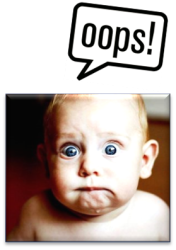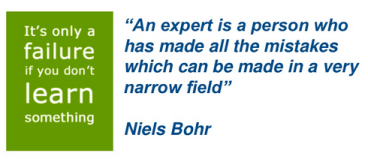The Learning Circuits Blog big question this month is:
How do you respond to the “I want it now!” request from a demanding executive?
 They provide the scenario of a Type A executive with a website open on rapid instructional design prompting the “I want it now” request. (Hard to imagine i know, and if true presented an excellent “teachable moment” with that executive!).
They provide the scenario of a Type A executive with a website open on rapid instructional design prompting the “I want it now” request. (Hard to imagine i know, and if true presented an excellent “teachable moment” with that executive!).
While “I want it now!” is a common demand on training functions, it’s certainly not unique to us. Ask the IT, Marketing, or Administration function and you’ll hear the same groans of recognition. The strategies for dealing with the situation are the same and they have more to do with relationship building and consulting approaches than anything related to how quickly you can throw together a training program to meet the request.
Here are a few strategies that might help.
1. Prevention
The best strategy is a preventative one. Training functions should have annual plans in place with their internal clients identifying skill and capability development priorities based on the business and functional needs. The plan is ideally part of the planning cycle of the organization so business needs are “in the air” and being cascaded through the organization on a number of fronts. For each group you support, the plan could include:
- strategic and operating goals for the year
- pivotal roles involved in achieving them
- skill, knowledge and capabilities required for each role
- training and learning approaches and programs to be developed/acquired
- agreement on responsibilities of client and learning function
- review plan
The joint planning process itself helps build mutual understanding of the requirements for meaningful learning solutions and informal learning regarding those situations when knee-jerk training is not a solution at all. You may be lucky enough never to get the “I want it now” request at all. When they do come (and you know they will) and they deviate from the jointly developed plan, you can legitimately ask what other priorities need to be dropped, and what resources need to be added, in order to fulfill this new request.
2. Rapid performance analysis
Along with your heart rate, the “I want it now” demand should raise your performance antenna. This is your opportunity to apply the performance analysis process you know well in theory if not in practice. There may be other root causes at work and you have a responsibility to suss them out.
But that’s not what your Type A executive asked you to do is it? So this is not the time for a lengthy root cause analysis, but it does justify a rapid performance analysis. This is why relationship building and consulting skills are as important as process skills for the learning professional. You will need to muster your knowledge of the organization, your business acumen and the factors that impact performance to quickly ask the right questions to get to the bottom of the “issue”. Responding to the “I want it now” demand with an analysis is tricky. Do it well however and you may earn the respect that will avoid future “I want it now” demands.
There are a number of rapid analysis tools available that are based on “performance thinking” approaches. For years I’ve used my own adaptation of Thomas Gilbert’s PROBE questioning heuristic. There are many others.
2. Provide the learning “artifact” but fix the real problem
Your rapid performance analysis may indeed point to other root causes. If your executive is blind to this despite your best efforts, you may need to provide the learning artifact but sneak in the real solution while doing so.
The “I want it now” executive is usually not as specific as you may be on what a learning program actually is. This frees you to design a “program” that can be a performance solution in the guise of a training program. But if you’re A type exec wants you to call it that, why not?. If your program includes an improved feedback system, better information resources and a process fix all communicated through small training session to help employees use these simple performance support tools, you have fixed the problem and provided a “training program”. And again, often all of this can be done faster then slogging through the development cycle of a full blown training program loaded up with rigourously defined learning objectives and practice activities.
4. Do it!
Your executive may be dead on. Don’t discount this possibility. Things change pretty quickly in business these days. Roles and skills can take unexpected turns to meet emerging business requirements. At least you have an executive that considers the importance of skills and knowledge needs and cares enough to make the call to you, abrupt as it may be. If that is the case, then perhaps a rapid solution is exactly what is called for. A lean program built with basic job aids, performance support tools, and creative information design can often be done even faster than “rapid e-learning”. Rapid tools are made for this kind of scenario and they can be very useful. But creative thinking with a laser focus on actual performance requirements might be even faster.
5. Don’t do it!
If your professional judgment tells you that this project would be folly and waste important resources, or if it you believe it has lass than a 50% chance of success, you have the responsibility to say no. Be prepared to back up your response and provide alternatives if appropriate. This is a risk not many take with the type A executive demand. The upside is intact professional integrity and the knowledge that you have saved the company some wasted effort. The downside is…well that’s what keeps life interesting isn’t it 🙂
Each of these strategies requires strong professional judgment, authentic relationships and sound consulting approaches with your “client”. These skills include:
- Contracting
- Understanding and dealing with resistance
- Building relationships
- Providing feedback from analysis
- Authentic interactions
- Managing feedback meetings
- Internal negotiation
In my experience, the best source of guidance for these skills in our profession remains Peter Block’s Flawless Consulting.
So you better get on that. I want it now!
 The language of employee engagement is growing in HR and training circles. Engagement is being used both as an explicit goal and measure of successful interventions. But what is the relationship between engagement and performance? Can we assume that more engaged employees perform better? Taking it further, can we assume that engagement causes improved performance?
The language of employee engagement is growing in HR and training circles. Engagement is being used both as an explicit goal and measure of successful interventions. But what is the relationship between engagement and performance? Can we assume that more engaged employees perform better? Taking it further, can we assume that engagement causes improved performance?













